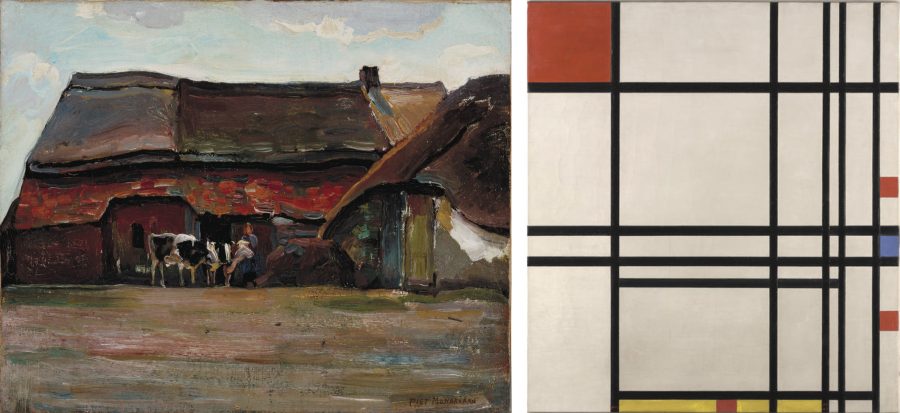Framing the Allen: Abstraction Shows Artist Evolution
Photos Courtesy of Megan Harding
Brabant Farmyard, left, and Abstraction, right, are currently on display at the Allen Memorial Art Museum. The latter is on loan from Fort Worth’s Kimbell Art Museum.
September 23, 2016
The Allen Memorial Art Museum holds nearly 14,000 objects in its own collections. With the physical limits of its galleries, there is no way to exhibit all of this art.
This is the first installation in a bimonthly column in which the Review will be bringing unseen favorites of the AMAM staff to the Arts section.
Lending and borrowing artwork, according to Andria Derstine, John G. W. Cowles Director of the Allen Memorial Art Museum, is a way for museums to bring greater richness and variety to the viewing public. The AMAM and its curators work to create meaning through the combinations of pieces they own and loan. For example, in the John N. Stern Gallery of the museum, there are usually two Monets and one Mondrian on display. Until Dec. 23, that ratio is backwards: in place of Monet’s early work Garden of the Princess, Louvre is Mondrian’s late work Abstraction, on loan from the Kimbell Art Museum in Fort Worth, Texas.
Dutch painter Piet Mondrian is best known for his De Stijl movement works like Abstraction (1939-1942), which are characterized by white canvases striped with perpendicular black lines, intermittently filled in with primary-colored rectangles.
The AMAM’s presentation of the work is special because it is displayed in conjunction with Mondrian’s 1904 work Brabant Farmyard, part of the AMAM’s permanent collection. This early piece is strikingly different from his later, better-known style.
At first glance, Brabant Farmyard is nearly unrecognizable as the work of Piet Mondrian. Even his signature is abstracted from the first to the second — what begins as a full name scrawled at the bottom of Brabant becomes a concise “PM” within the black matrix of Abstraction.
“When I first came to Oberlin as a curator at the Allen in 2006, I remember being shocked that this was a Mondrian,” Derstine said. “Before, I had only associated [the artist] with his later, more abstract works.” However, closer inspection of the two pieces side-by-side reveals clues that the same artist could have created them both.
Brabant Farmyard is a landscape oil painting of a Dutch barn in muted primary colors and gray-greens, with two women attending to a pair of cows in the foreground. The piece fits into a niche at the AMAM within the Hague School artists with whom Mondrian studied early in his career. Abstraction, on the other hand, is boldly geometric, seeming to pop out of the wall against its original white wooden frame. The works are part of the same series, a diachronic view of Mondrian’s stylistic development. Even in his early work, the observant viewer can see the geometry in Mondrian’s composition. The roof of the barn, the barn itself and the earth and sky are sliced into quadrangular forms, right angles abounding.
Mondrian uses primarily reds, blues and earth tones in this work. Although the colors of Brabant are muddied and dark in comparison with the brightness and clarity of tone in Abstraction, it is clear that he is already defining the palette he became famous for.
“[Brabant] does look more solid and modern than the works of his Hague School compatriots, and the sky is almost impressionistic,” Derstine said.
The works of these other painters, such as Anton Mauve, Jozef Israëls and Jacob Maris are also in the collection and visible in the AMAM’s online e-museum, but are not currently on display. While their paintings give some contextual clues to Brabant Farmyard, they lean much more heavily toward Realism than Mondrian’s piece.
Abstraction draws much more on Mondrian’s beginnings in painting the natural world than it appears. Mondrian intended for his “plastic works” to send an important message about humanity’s relationship with nature.
“Observing sea, sky, and stars, I sought to indicate their plastic function through a multiplicity of crossing verticals and horizontals,” he once wrote. “The clarification of equilibrium through plastic art is of great importance for humanity. It reveals that although human life in time is doomed to disequilibrium, notwithstanding this, it is based on equilibrium.”
The AMAM is extraordinary among its peers partly because of its collections of many early works by well-known artists. These early pieces give museum-goers a long view of an artist’s oeuvre, allowing for a fuller understanding and more complete education of the artist or the development of a school of art. That is why the Kimbell curators came to the AMAM with the request to borrow Garden of the Princess, Louvre, and why Brabant Farmyard is such an important and unique piece in the museum and in Mondrian’s history as an artist.
“One of our major goals is to involve faculty and students in the museum,” Derstine said. “That Monet [Garden] is one of our most iconic works and is used by a lot of professors in their classes, so I wanted to get something in return that would contribute to community engagement at the Allen. Ever since I got here, it has been a dream of mine to display a more canonical Mondrian, and this was the perfect opportunity.”
Seeing these two aspects of Piet Mondrian’s painting life, bookends of his career, sitting a foot away from each other on the same wall is a testament to the potential of museum loaning. For the semester, Oberlin can examine the results of a lifetime of work, pared down to two different yet harmonious pieces.

















